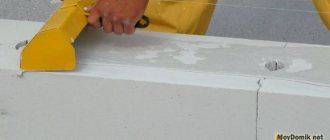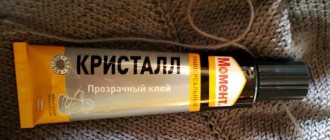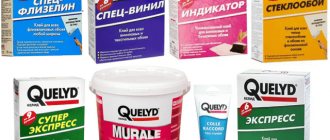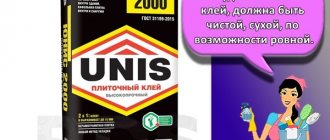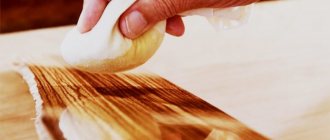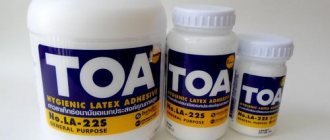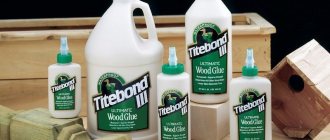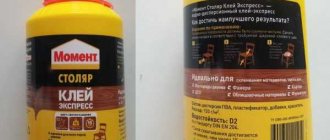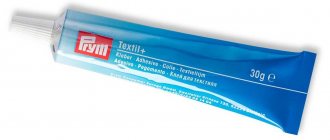Polyurethane glue has become widespread in the repair and construction industry due to its versatility and the presence of many advantages that standard PVC or types of wood glue do not have. The polyurethane composition is characterized not only by high quality, strength and reliability of adhesion, but also by resistance to aggressive chemicals. Thanks to the substance, it is possible to bond various materials and surfaces, including fabrics, metal, plastic, wood, and various minerals. It is important to follow a special application technology during the work, as well as choose a suitable one-component or two-component composition.
Features and Benefits
Polyurethane-based adhesive has a special curing principle. This process occurs upon contact with moisture from the environment or a special hardener substance. When a substance begins to polymerize, a film forms on its surface. That is, a chemical reaction occurs during which foaming begins due to the release of carbon dioxide.
Polyurethane adhesive is a universal substance that can be used in various fields and industries. Polyurethane glue can be used to connect natural and artificial surfaces in various combinations. You can select the composition to work with metal, stone, wood, fabric, plastic, rubber, gravel, glass, polystyrene, ceramics, cardboard.
When using polyurethane-based glue, you can notice the following advantages:
- Provides long-term and high-quality connection.
- Guarantees high adhesion to both smooth and porous substrates.
- It is characterized by high moisture resistance, provides strength and tightness to the seams.
- It is resistant to high and very low temperatures, that is, heat and frost resistance.
- After complete curing, high strength joints are ensured.
- It is characterized by chemical resistance to various acids, gasoline, oils and other aggressive substances.
- Characterized by a long working time.
Note! Polyurethane glue cannot be used to connect polyethylene silicone coatings and polypropylene coatings. The quality of the adhesion will deteriorate significantly if there is an oil or wax layer on the surfaces. If it comes into contact with the skin and mucous membranes, the substances in the glue can cause irritation, so you must take safety precautions when using it.
How it is produced
Many people who are going to use such adhesives are interested in the features of their production.
An adhesive composition is produced on a polyurethane basis from synthesized microelements. Some manufacturers add components to it that help harden the applied adhesive liquid. Most often, a synthetic resin is used for this, due to which the mixture becomes more viscous and thick. Composite materials can also be added to the glue to improve its adhesive properties. To increase reactivity, hydroxyl-containing compounds are added to the adhesive composition. When creating moisture-resistant compositions, aminoimides are added.
See also
How and how to properly glue plywood together with your own hands, types of compositions
Properties and characteristics
Synthetic polymer adhesive contains film-forming substances, and you can also find viscosity regulators, resins, stabilizers and crystallization accelerators. To harden the substance, hydroxyls and isocyanates are added. The difference between polyurethane glue and substances based on aqueous dispersions is that the ratio of solids in its composition will be higher.
The hardened glued joint can be used under environmental conditions from -40 to +120°C. It provides good adhesion to smooth, porous, and rough surfaces. Moreover, such a result can be achieved only if all the rules for using glue are observed:
- Work on applying the substance should be carried out at a temperature of at least +15°C.
- The substance has thixotropic characteristics, so it is necessary to wait the recommended period for it to completely harden.
- Polyurethane one-component adhesive also has moisture-resistant properties, so it is resistant to bacteria, the spread of fungus and mold.
When planning repair work, it is necessary to calculate the consumption of polyurethane glue in advance. With uniform, continuous application, this figure will vary between 500-1000 g per 1 m²; this figure is determined by the type of material to be worked with, as well as the thickness of the layer being created. For spot application of glue, the consumption is 150 g.
Between themselves, adhesive solutions can differ in color and viscosity. This is determined by the purpose of the substance. For woodworking, the color of the product ranges from amber to dark brown. You can find polyurethane solutions in white, yellow and gray. The universal composition is available in the form of a transparent substance. According to consistency, adhesives can be liquid or gel-like.
You can buy a solution of polyurethane glue in different volumes and packaging. If you need a solution for household use, you can purchase a tube with a volume of 20 to 310 ml. There are large volumes in containers starting from 750 g - these are usually cylinders or cans made of tin or plastic. If you pursue global construction goals, it is better to purchase glue in buckets weighing from 2 to 20 kg. If we imagine the consumption for production purposes, the product is supplied in 200 kg barrels, as well as in cubes.
Specifications
Polyurethane hot melt adhesive is a viscous liquid that comes in gray, white or amber shades. The two-component mixture comes with a container of hardener. Glue is sold in plastic or metal buckets up to 5 kg. The polyurethane-based mixture has excellent mechanical characteristics.
You can work with the mixture in conditions with temperatures from 0 to +40 degrees, and after pasting the composition can withstand from -50 to +120 degrees
Please note that for good adhesion, the surface must be thoroughly cleaned of dust and dirt and degreased before applying glue.
The properties of the glue also include preventing the formation of fungus and mold. During application, the mixture foams a little, due to which the space between the two materials is completely filled with the composition. No solvents are used to produce the glue, it is odorless, which has a positive effect on human health and the environment.
Purpose
Polyurethane adhesive can be used with equal effectiveness for external or internal finishing work, since this composition is not afraid of frost and humidity.
The application of this composition is very extensive:
- Used in the production of flexible stone for gluing fabric material with marble, limestone and graphite chips.
- Thanks to polymer compounds, elements of window profiles, slats, PVC edges and other elements are held together.
- The use of tile adhesive can be seen in construction, in particular when improving playgrounds. The composition is used for gluing an area with artificial lawn grass or rubber mats.
- Polyurethane adhesive for rubber and rubber crumbs is used in the manufacture of floor coverings and tiles, and even foam rubber sponges actively used in everyday life are glued together thanks to this composition.
- Actively used in the production of sandwich panels, the adhesive bonds the facing layer with the internal filler.
- It is a connecting link when attaching ceiling skirting boards, stucco moldings, cornices to static surfaces.
- Suitable for working with wooden beams and plastic elements.
- It can act as an adhesive for glass and connect ceramic elements, porcelain parts, and plexiglass structures.
- It is the best assistant in the restoration and repair of various metal and wooden furniture.
- There is a special type of glue for working with shoes, in particular, gluing insoles, heels, and soles. This glue can be used with any type of shoe materials: natural leather and suede, artificial fabrics, fur, and is also suitable for rubber soles.
- Provides reliable sealing of punctures in air mattresses, balls, circles, boats, PVC pools.
- It is actively used in construction for gluing various finishes, such as ceramics, porcelain stoneware, mosaic tiles, decorative stone, marble, various bases, even wood.
- A special variety of polyurethane is available for laying and working with any existing types of wooden floors. It gives the layer heat-resistant properties, so it can be used for arranging a heated floor system.
Important! The adhesive base, seams and joints will be reliable and of high quality, and will last a long time both indoors and outdoors. During operation they will not crack, peel or crumble. The glue is able to withstand any adverse environmental conditions and moisture.
Trade marks
There are several well-known manufacturers that produce polyurethane glue.
Adesiv
This is a high-quality two-component composition produced in Italy. Most often, Adesiv is used for gluing wooden products and laying parquet. The advantages of this glue include its elasticity, strength and reliability. Before use, Adesiv is mixed with a special hardener. The composition is mixed until a homogeneous mass is obtained. The prepared solution is applied to the surface using a spatula. Adesiv hardens within six hours.
See also
How and how to properly seal a battery with your own hands
Duayen
To work with rubber coatings, it is recommended to use Duayen glue. This two-component adhesive mixture tolerates low temperatures, high humidity and copes with the effects of many chemical components. Among the advantages of Duayen, which distinguish it from other types of polyurethane glue, are:
- Cheapness. Adhesive compositions from this manufacturer are several times cheaper than other similar products.
- Hardening speed. The glue applied to the surface dries within half an hour after application.
- Durability. The glue does not lose its properties even decades after use.
Purtis
Purtis are one-component adhesives that are most often used in the construction industry. They do not contain solvents or hardeners.
Experts advise using Purtis to glue particle boards together, as well as to sheathe the surface of walls with cotton wool boards or foam sheets. In addition, glue is considered a good tool for gluing SIP panels to aluminum, steel or plastic surfaces.
It is also resistant to heat and low temperatures, allowing it to be used outdoors.
"Anles"
A one-component adhesive mixture made from urethane rubber. The main feature of Anles is considered to be the high rate of crystallization of the adhesive composition. When creating such a substance, acetone and ethyl acetate are used.
Main properties of "Anles":
- operating temperature is about 20-50 degrees above zero;
- transparency after hardening;
- resistance to dampness;
- resistance to low temperatures, which allows Anles to be used outdoors;
- resistance to alkaline and acid mixtures;
- elasticity and high strength.
When using Anles, no more than 150 grams of glue are consumed per square meter.
"ATK-Alliance"
ATK-Alliance is considered the most famous industrial adhesive used in the manufacture of sandwich panels. It is intended for use in enterprises that are equipped with special automatic lines for the production of panels. The main advantages of the composition include:
- Low cost. Compared to other industrial polyurethane adhesives, ATK-Alliance is quite cheap.
- Water resistance. The composition does not allow moisture to pass through, which allows it to be used outdoors and in damp rooms.
- Frost resistance. "Alliance" does not lose its properties even at temperatures below 50 degrees below zero.
"Cleon"
When making furniture, they often use Kleon, which is designed for working with wood. This adhesive is available in small containers of 400-500 milliliters. The main advantages of "Cleon" are:
- Fast setting. The adhesive applied to the surface begins to set 8-10 minutes after use.
- Resistance to moisture. "Kleon" easily copes with dampness and therefore can be used in a humid environment.
- Resistance to temperature changes. "Cleon" copes with temperature fluctuations from -30 to +40 degrees.
Soudal
Among the household varieties of adhesives, Soudal is distinguished. It is made from rubber and contains a small amount of solvents. Due to its good adhesion and high-quality connection, Soudal is used to work with any surface.
Before applying the composition, the surface is degreased and wiped from dirt and dust particles. To make the connection more durable, Soudal is applied in 2-3 layers. The connected products must be pressed tightly against each other and held in this position for about 20-25 minutes.
"Moment"
One of the most common types of polyurethane adhesives used in everyday life. The “moment” is used when you need to quickly glue broken objects together. Experts recommend using glue for gluing plastic products. It is suitable for working with rubber, metal, wood, ceramic and glass coatings.
See also
Types and scope of application of fish glues, how to make them yourself
The only thing “Moment” is incompatible with is polypropylene and polyethylene. It is also not recommended to use polyurethane glue for gluing dishes and food storage containers.
Bostik
People who plan to do renovations and glue wallpaper to walls can use Bostik adhesive for this. This is an ideal product for gluing paper-based products and gluing them onto cement, wood and fiber substrates. Bostik is poorly protected from dampness and therefore is used in dry rooms.
Before gluing wallpaper, you need to prepare the surface of the walls. They are pre-plastered and sanded to ensure a perfectly smooth finish. Then the walls are evenly coated with adhesive. To do this, use a regular brush or roller.
Dow Chemical Company
A universal one-component polyurethane composition used for gluing any materials. It is often used during renovations for gluing parquet, ceramic tiles, wallpaper, baseboards and linoleum. Also, glue produced by the Dow Chemical Company perfectly bonds rubber and natural leather.
A special type of adhesive liquid is produced that is used to work with shoes. Soles, heels and even insoles are glued.
Henkel
Furniture companies often use Henkel glue. Its advantages include:
- Strength and durability. Glued wood does not come unglued even after several decades.
- Fire safety. The surface treated with the mixture is not flammable.
- Resistance to dampness. Henkel is often used in high humidity environments as it is waterproof.
- Versatility. Glue is used both for machine gluing of wood and for manual gluing.
Kinds
Based on their composition, there are two types of glue: one-component and two-component.
The one-component mixture is available ready for use. It polymerizes only under the influence of water or moisture. The composition differs in that it foams more actively if the air humidity exceeds 60%. When a chemical reaction occurs, the glue begins to increase in volume. This feature must be taken into account when distributing the composition over the surface and planning the flow rate.
Two-component polyurethane tile adhesive contains 2 main components that must be mixed before starting work. It is very important to maintain the correct proportionality, since otherwise the chemical reaction simply will not occur and the glue will not harden. You can find quick-drying substances on sale that need to be treated at hot temperatures of 80-110 °C.
One-component polyurethane adhesive is considered a universal composition; it is suitable for crushed stone, rubber, many other materials, as well as their combinations. It is an excellent alternative to heat-resistant automotive sealant and provides parts with corrosion protection.
Peculiarities
Almost the entire composition of polyurethane glue is solid synthetic resins, which distinguishes this mixture from all analogues. In them, resins are only a small part of the composition, the rest is water. A special feature of a polyurethane product is its hardening. Upon contact with water vapor, it enters into a chemical reaction, resulting in the creation of a durable film. Also, during the reaction, carbon dioxide and bubbles are released, which makes the polymerization process similar to the drying of polyurethane foam.
There are two-component and one-component polyurethane adhesives. The second consists of isocyanate prepolymers, is easy to use and allows you to quickly do a large amount of work. It has high viscosity, thanks to which any material instantly sticks to the required surface.
Two-component contains two substances that, when unmixed, have low viscosity. And only after mechanical mixing does the glue take on its working condition. The procedure for mixing components requires certain temperature conditions and specific proportions.
The polyurethane composition has a number of advantages, which is why it is in demand among buyers.
- resistance to high humidity - this mixture can be used even on the streets for garden furniture, which is used all year round in any weather;
- reliability and strength - the glue guarantees high-quality bonding when joining different materials, even damp wood or wood coated with all kinds of antiseptics;
- open holding time – when working with polyurethane glue there is no need to rush at all, in about 20 minutes you can carefully apply the composition and apply all the parts with precision;
- comfort during work - the glue ensures the sliding of lubricated elements, which is convenient when assembling tight structures;
- It is appropriate to use for laying parquet - the mixture firmly fixes the wood to the floor and prevents the material from swelling.
Application rules
When applying one-component or two-component tile adhesive, the working surface must first be prepared. It is cleaned from dust and dirt, debris and various substances - this could be old plaster, cement, paint. To guarantee good adhesion of surfaces, it is necessary to degrease. This will help completely eliminate traces of grease, oil or other chemicals, if any have been used previously. For cleaning, you can choose regular alcohol or solvent.
Important! Additionally, it is necessary for the master to provide safety measures during work. These are, first of all, personal protective equipment in the form of gloves and a respirator. Good ventilation must also be ensured in the room.
Rules for applying glue:
- Polyurethane glue must be applied in a thin layer, preferably evenly over the entire surface. To do this, you can use either a plastic construction spatula or other convenient means at hand.
2. Polyurethane in combination with a solvent must be applied to the two surfaces to be bonded; the manufacturer also states this in the instructions on the packaging. If you need to glue a porous material, you will need two layers of polyurethane glue, which are applied at intervals of 2-5 minutes.
3. When using aerosol adhesive foam, it must be applied in uniform stripes along the entire perimeter of the plane, retreating from the edge at least 8 cm, with 10-25 cm of exposure between the stripes.
4.After application, the adhesive composition must be left to dry on the surface for 5-10 minutes, after which the materials must be combined, applying strong pressure to them.
5.To speed up the drying process and increase the moisture resistance of the adhesive joint, you need to wait for it to dry initially after 20-90 minutes, according to the instructions. Then use a hairdryer and heat the joint for several minutes, then connect the adhesive surface and leave under pressure for 5 minutes.
Advice! A tool such as a roller will ensure good adhesion of materials. You need to roll it over the surfaces several times, pressing firmly. To speed up the setting and chemical reaction, you need to lightly spray the adhesive side with water.
Application and safety rules
Polyurethane sealant soudal
If you are working with wood with a moisture content of less than 8%, both surfaces are sprayed with water, the liquid is allowed to be absorbed, and only then gluing begins. Before this, other preparation measures must be taken: dirt, debris, dust, grease and other contaminants are removed. The bases are also cleaned of cement, plaster, and paint. To degrease, wipe with alcohol or solvent.
The glue is applied in a thin layer over the entire surface. It is especially convenient to do this if the glue is in aerosol form. Thick pastes and viscous solutions are applied and distributed with a spatula. Two-component adhesives are first mixed according to the instructions, then similar steps are performed. The rules for working with polyurethane are as follows:
- the amount of glue should be small, otherwise the expanded layer will turn out to be too thick;
- complex bases are covered on both sides to be glued, others - on only one;
- porous surfaces are treated with glue in 2 layers, the second is applied 2-3 minutes after the first;
- aerosol adhesives are sprayed in even stripes every 10 cm, retreating 8 cm from the edge;
- after application, the product is allowed to dry for 5-10 minutes and only then the parts are fixed with strong pressure on them (if possible, roll the product with a roller);
- After a tight fit, the elements of the product are secured with a clamp and left for 1.5 hours;
- after the polyurethane has dried, the remaining foam residues that have come out are carefully scraped off with a chisel;
- You can use the product within a day.
To prevent the remaining glue from deteriorating, the bottle must be squeezed to allow air to escape, then immediately screw on the cap. To speed up drying, the adhesive layer can be treated with hot air from a hair dryer and only then the parts can be connected to each other.
Polyurethane adhesives contain organic solvents, so they are harmful to the body. When working, ensure good ventilation and wear a respirator. If glue gets on your skin, it requires immediate washing with soap and water, otherwise irritation may occur. When gluing objects, you should only wear rubber gloves.
How to dilute and wash
If it is necessary to mix two-component polyurethane adhesive for crumb rubber with a hardener, then no additional substances should be added. To increase adhesion and increase heat resistance, the Desmodur activator is added to the composition in an amount of approximately 6-7% of the total mass of the main substance. If one-component polyurethane adhesive is used for stone or any other finish, then it is unacceptable to add alcohol or water to the composition. The only exceptions are those cases when the glue is very thick and difficult to distribute over the surface.
On sale you can find special thinners for polyurethane glue, which simultaneously act as viscosity optimizers. An alternative to them is acetone, ethyl acetate, methyl ethyl ketone. If you use toluene, you can notice a significant increase in the composition of the glue in volume.
After completing repair work using polyurethane glue, you must immediately clean the tool, preventing the substance from hardening. To remove dirt, you can use rags pre-moistened in acetone or solvent. If the glue has dried on clothing or other surfaces, it can be removed using acetone or mechanically.
On video: How to prepare an adhesive mixture of polyurethane two-component adhesive.
What and how to breed
Polyurethane construction adhesive may need to be thinned over time as it loses its viscosity. You can dilute it with alcohol, but you should not add too much diluent, a few ml, no more, it will worsen the properties of the binder composition.
You can use specialized solvents for urethane adhesive. A suitable solution is toluene, but it will make the seam thicker.
You can dilute with alcohol, but do not add too much diluent.
How long does it take to dry?
The hardening time of polyurethane glue is determined by its composition, as well as the presence of additional ingredients in it. On average, this time ranges from 20 minutes to 1 hour. While the glue is in a liquid state, it is necessary to press the glued base very tightly to ensure fixation for a short period. It would be optimal to apply pressure to the surfaces for 1 hour to ensure uniform, tight and reliable fastening.
During work, some of the glue may appear on the surface of the materials after curing, so its excess is removed mechanically. Complete hardening of the adhesive composition occurs in 1-2 days. During this time, the adhesive seam becomes as strong as possible. During this period, it is necessary to ensure that the surfaces being bonded are static and at rest, and free them from mechanical influences. The curing time can also be influenced by the ambient air temperature. If a hot method was chosen for polymerization, then complete curing will be completed after 4 hours.
Adhesive foam for aerated concrete, advantages
No “waste space” - no air flow through the walls
Voids in vertical seams (less often in horizontal ones) are a very common problem, the negative consequence of which is heat loss and air flow through the house through the seams. The reason is the consistency of cement-sand glue or mortar: it can be compared to thick sour cream. From a vertical surface, the glue slides down under the influence of gravity.
What, gravity doesn’t affect PPU glue? Of course it works. But polyurethane foam adhesive has higher adhesion to the surface of the block and, most importantly, the blocks “grab” each other in a matter of minutes.
Also, there is a combined technology, when in the construction of aerated concrete, cement-sand glue is used for horizontal joints, and PPU glue is used for vertical joints
Thin sealed seams - reduce heat loss in the walls
One of the main advantages of an aerated concrete block is its low thermal conductivity. The lower this indicator, the “warmer” the material. For example, the thermal conductivity of Twinblock D400 is only 0.106 W/mS. But in order to fully use this quality, it is necessary to minimize the appearance of “cold bridges” in the seams.
The thermal conductivity of masonry mortars is several times higher than the thermal conductivity of the block. Therefore, to put it simply, the thinner the seam, the warmer it is in the cottage. The thickness of the seam when using cement-sand mortar reaches 10-12 mm. Cement-sand glue and PPU glue allow you to make seams from 1 to 3 mm, but the latter is distributed more evenly and forms a continuous contour.
When using cement-sand mortar, thermal energy losses can amount to up to 40% of the total heat loss of the wall, when using thin-layer adhesive - less than 10%.
Masonry with adhesive foam - high construction speed
The speed of construction when using PPU glue is achieved due to several factors:
PPU glue is a finished product. You don’t waste time diluting and mixing the solution, just connect the cylinder to the gun - and use it;
Applying foam glue from a can to Twinblock
Bonus: At a construction site you don’t need a mixer, water, or additional containers, i.e. there are no so-called “dirty jobs”, and walls can be laid even at negative air temperatures
Clean house wall and clean construction site
Has everyone seen country houses under construction with smudges on the walls? This happens because the mortar or glue is squeezed out of the seams under the weight of the block. The wall looks untidy, and this is not just an aesthetic defect that you can put up with: before finishing, the smudges will have to be removed, that is, resources (time, money) will be spent. In addition, you also paid for the volume of solution that will go to the landfill.
There will be no leaks when laying on polyurethane adhesive foam. The glue is applied in one or several (depending on the width of the block) strips and, under pressure, is evenly distributed over the surface of the block
Result: the masonry looks more neat; the wall does not need to be “cleared” before finishing. By the way, this will allow you to further save on the total construction cost estimate by using external walls without finishing (just chamfer the edges of the block and you will get a nice and durable wall surface without additional costs of money and time).
Durable masonry – stability and durability of the house structure
Polyurethane adhesive foam provides high adhesion (adhesion) of aerated block masonry. With PPU foam glue, the block quickly “sets”: after 3 minutes the blocks can no longer be moved and after drying they cannot be torn apart. High adhesion also has a “side effect”, more about it below.
Ability to build in sub-zero temperatures
There is no water in the composition of polyurethane foam adhesive, so negative temperatures are not critical for it. And, as we indicated above, when using this technology, there is no need to wet the surface of the block. Therefore, you can put the block on PPU glue even in slight frost (down to -10℃).
How to store
Polyurethane binder or adhesive for crumb rubber has the following storage features:
- If the container is closed, then the optimal storage temperature is +10…+30°C.
- The container should be located away from open flame sources, direct sunlight, and heating devices.
- On average, the shelf life is 12-24 months, depending on the manufacturer and the date indicated on the package.
- After opening the package, polyurethane glue can be stored for approximately six months. Therefore, during this period you need to try to use it up.
- When the package is opened, air enters it, which means moisture penetrates. Therefore, some part of the glue becomes thicker or even hardens. Therefore, it is necessary to ensure that the cap is tightly closed to prevent moist air from penetrating inside.
Advice! To prevent the holes from becoming clogged during storage, the tube must be in a vertical position on the lid.
Best before date
The guaranteed shelf life of polyurethane adhesives ranges from several months to several years in a cool, dry and dark room. The optimal temperature of the warehouse should be from +10 °C to + 25 °C.
To prevent hardening, the container with glue must be tightly closed at the end of work. Otherwise, the remaining glue cannot be used effectively.
Manufacturers
On store shelves you can find an abundance of polyurethane adhesives from various manufacturers, including domestic and foreign, including countries such as Turkey, America, Italy. In the vastness of Russia there are also many companies that produce polymer glue, oriented for use on a production scale, and also suitable for household use.
The following manufacturers deserve attention:
1. Adesiv is an Italian brand that produces two-component Pelpren PL6 adhesives. The composition is suitable for professionals, as it is produced on the basis of epoxy resin and polyurethane. Ideal for working with wood.
2. Bostik is an American manufacturer that produces one-component and two-component compositions for installing parquet.
3. Dow Chemical Company is an international brand that produces universal Insta-Stik formulations packaged in 750 ml, 10.4 liter volume containers. Ideal for working with insulating materials, ensuring their fastening to any horizontal and vertical bases.
4. Duayen is a Turkish company that has been supplying polyurethane glue to Russia since 2001. PU glue is used mainly in grades A-121 and A-338 for rubber bases, as well as bonding to rubber, metal, wood and concrete. Brand A-138 is suitable for creating rubber floor coverings for the street, A-118 provides reliable fastening of parquet flooring, A-128 is used in shipbuilding and furniture production.
5. Henkel from the German brand also sells polyurethane adhesive for various purposes in Russia for household use and industry.
Using polyurethane glue (2 videos)
Polyurethane glue (16 photos)
Types of glue polyurethane glue
Before using the product, you need to know about the characteristics of a particular type:
- With one substance is an artificial mixture formed on the basis of isocyanates. In appearance, it appears to be a thickened gray liquid with a slight whitish tone. In order to make the contents of the glue more viscous, you need to pour acetone or other solvents into it. The adhesion of the glue will increase due to the addition of artificial resins. The described compositions are sold in fully prepared form, and their hardening occurs after contact with water. Further hardening occurs when the air humidity level is more than 65%.
- With two ingredients – the content contains two active ingredients. The first ingredient is a combination of polyhydric alcohols with polymers, and these microscopic elements affect the viscosity, plasticity and strength of the composition. Another ingredient is diisocyanate, which is needed to thin the glue. Adhesives with two ingredients have a very wide range of applications, and the ingredients included in the composition are able to provide reliable bonding. The original bond of the glued ingredients remains strong even after decades. Shows resistance to high levels of moisture, including temperature changes.
Expert advice
Sometimes you can purchase low-quality material, expired, without certification, or manufactured at an unknown enterprise using unknown technologies.
When purchasing polyurethane adhesive for rubber tiles, you must carefully study the information on the packaging. It should indicate the expiration date, the manufacturing company with its legal coordinates, the location of the facilities, and a telephone number where you can contact a company representative.
Detailed instructions for using the content must be attached separately.
Solvent-based polyurethane adhesives based on hydroxyl-containing polyurethanes.
Organic polyurethane adhesives typically contain a flexible polyurethane polymer dissolved in an organic solvent. In this way, the solid polymer can be applied to the substrate. The solvent promotes wetting and then evaporates, causing the adhesive to physically harden. Linear hydroxyl-containing polyurethanes based on crystallizable polyester segments are usually processed as thermally activated adhesives. By briefly heating above the softening point of the crystalline polyester segments, the dry, non-tacky film formed after solvent evaporation acquires the tack and flow required for the registration process. In this state, the adhesive layer can be combined with the second layer by applying slight pressure to form a homogeneous adhesive joint, which is subsequently physically cured due to re-crystallization of the polymer. Isocyanate cross-linking
. To prevent softening of the thermoplastic adhesive film when exposed to heat, such adhesives are often produced in the form of a two-component composition, introducing an isocyanate hardener of higher functionality. It significantly increases the softening temperature of the adhesive layer and its adhesion to the substrate. First, the adhesive layer physically hardens. Chemical cross-linking requires a little more time. The softening temperature of the cross-linked adhesive layer increases significantly, as does its resistance to solvents, plasticizers, and the migration of oils and fats.
Adhesives based on highly crystalline polyesters form a strong adhesive joint even with PVC with a high content of plasticizers, which determines their use in the footwear, furniture and automotive industries. Products containing less crystalline polyesters are characterized by high elasticity and better adhesion to non-polar substrates. Therefore, they are used for laminating films.
Although solventborne adhesives are often processed as one-component systems, the additional use of an isocyanate hardener is recommended. Curing significantly increases the heat resistance of the adhesive joint, improves adhesion to the substrate and resistance to hydrolysis, solvents, plasticizers, oils and fats.
Polyurethane water-dispersion adhesives
consist of high molecular weight polyurethane dispersed in water, which cures due to evaporation or migration of water. Compared to organic adhesives, they have a lower viscosity and a higher solids value. Among them, products designed for thermal activation of bonding predominate. They consist primarily of linear macromolecules containing crystallizing polyester segments.
Once dry, the adhesive forms an unblocked film that must be activated (decrystallized) for bonding by brief exposure to heat. Thermal activation makes the film sticky; the crystalline polyester segments of the polymer are melted in a tunnel oven or by infrared irradiation at a temperature above the minimum activation temperature.
As with solventborne adhesives, heat-activated polyurethane waterborne adhesives can only achieve their full potential through chemical crosslinking. Isocyanate groups react with reactive groups of the polymer chain. Thus, the adhesive layer is cured first physically, then chemically. The softening temperatures and barrier properties of the cross-linked adhesive film increase significantly. The NCO groups of the isocyanate hardener slowly cross-link the polymer in the dried adhesive film. This leads to a decrease in the tack and fluidity of the thermally activated adhesive film with a slow increase in temperature. The adhesive layer must be thermally activated and used within a maximum of 8 hours after applying the adhesive dispersion.
Thermal activation is best carried out by short heating (shock activation, for example, due to infrared radiation), since the substrate remains practically cold. Hot tack time is the period after the end of thermal activation during which the film exhibits sufficient stickiness and fluidity required for gluing. The substrates must be combined within this time, which can range from a few seconds to several minutes depending on the polymer structure.
Thermally activated products form very strong adhesive contacts, especially on the surface of substrates containing plasticizer. They differ in the degree of crystallinity, crystallization rate and activation temperature. Products that crystallize more quickly after thermal activation are capable of more quickly absorbing the stresses that arise in the adhesive joint after gluing. This property attracts interest in the production of furniture facade panels by laminating decorative films onto MDF fiber boards. The applied and dried film on the MDF board is activated through a pre-heated decorative film. After removal from the laminating press, the adhesive contact must absorb the relaxation stresses of the decorative film, which has been subjected to intense discharge in several areas.
Products that are slower to crystallize after activation have a longer open time, resulting in increased time during which parts can be moved and joined, which is useful in shoe manufacturing for bonding soles.
Polyurethane dispersions with a low activation temperature (40-50⁰C) are used for gluing heat-sensitive substrates.
In the automotive industry, deep vacuum forming processes are used to produce laminated interior parts. The pre-heated laminate film is vacuum-stretched and bonded to the molded part coated with adhesive.
Polyurethane hot melt adhesives
exhibit very good adhesive properties.
They are chemically inactive materials in the form of films or powders based on hydroxyl-containing polyurethanes with crystallizing polyester segments. Used in the temperature range from 60 to 130⁰С, they harden physically as a result of cooling and crystallization. In contrast, reactive hot melt adhesives
are composed of fusible polyurethanes with isocyanate groups that are solid at room temperature. They are used at temperatures from 100 to 140⁰C and initially harden physically, upon cooling, and then chemically, the free isocyanate groups react with atmospheric moisture to form polyurea structures. Depending on the formulation, reactive polyurethane hot melt adhesives vulcanize to form elastomeric layers ranging from flexible to rigid and dense.
The initial strength of the adhesive joint depends on the temperature of the substrate, since temperature increases the viscosity and re-crystallization of the adhesive film in the adhesive joint.
If the substrate is too warm, the initial bond strength will be too low. If the substrate is too cold or dissipates heat too quickly, the adhesive may cure too quickly and no longer adhere to the cold substrate or wet the parts being bonded. To achieve the final strength of the adhesive joint, the presence of moisture is necessary. Depending on the rate of moisture diffusion into the adhesive film, it takes from 3 to 7 days before final vulcanization.
One of the most important areas of application is the lamination of textile materials. Adhesion is achieved by thermal activation of a spray-applied powder, extruded adhesive film or adhesive non-woven material and subsequent compression of both substrates. Another area of application for hotmelt adhesive films can be found in the automotive industry, in the finishing of outer textiles for back-spinning processes or in the coating of insulating foam shells. Hot melt adhesives are also used in the production of shoe uppers or pre-coated surface films for cabinet furniture.
Thermo-activated hydroxy polyurethane powders become tacky at very low temperatures, making them suitable for soft lamination of heat-sensitive substrates such as high-quality textiles. Thanks to good fluidity in the activated state, an adhesive joint is formed even at low pressure and short holding times. In this case, the danger of perforating the textile base is low.
Specially developed polyurethane hot melt adhesives are used in many areas: bookbinding, assembly and packaging of profiles in the furniture industry, production of textile composites and laminates, metal doors and office partitions, sandwich panels, window frames, automotive lighting elements.

